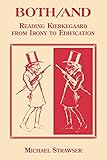Both/And : Reading Kierkegaard- From Irony to Edification / Michael Strawser.
Material type: TextSeries: Perspectives in Continental PhilosophyPublisher: New York, NY : Fordham University Press, [2023]Copyright date: ©1996Description: 1 online resource (261 p.)Content type:
TextSeries: Perspectives in Continental PhilosophyPublisher: New York, NY : Fordham University Press, [2023]Copyright date: ©1996Description: 1 online resource (261 p.)Content type: - 9780823217007
- 9780823295197
- online - DeGruyter
| Item type | Current library | Call number | URL | Status | Notes | Barcode | |
|---|---|---|---|---|---|---|---|
 eBook
eBook
|
Biblioteca "Angelicum" Pont. Univ. S.Tommaso d'Aquino Nuvola online | online - DeGruyter (Browse shelf(Opens below)) | Online access | Not for loan (Accesso limitato) | Accesso per gli utenti autorizzati / Access for authorized users | (dgr)9780823295197 |
Browsing Biblioteca "Angelicum" Pont. Univ. S.Tommaso d'Aquino shelves, Shelving location: Nuvola online Close shelf browser (Hides shelf browser)

|

|

|

|

|

|

|
||
| online - DeGruyter Passions of the Mind : Unheard Melodies: a Third Principle of Mental Functioning / | online - DeGruyter Abraham Lincoln : A Press Portrait / | online - DeGruyter Abraham Lincoln, Constitutionalism, and Equal Rights in the Civil War Era / | online - DeGruyter Both/And : Reading Kierkegaard- From Irony to Edification / | online - DeGruyter Emma Spaulding Bryant : Civil War Bride, Carpetbagger's Wife, Ardent Feminist: Letters 1860–1900 / | online - DeGruyter Evil and a Good God / | online - DeGruyter Experience and God / |
Frontmatter -- Contents -- Key to Primary Source References -- Introduction: Reading Kierkegaard Philosophically -- PART ONE. THE DEVELOPMENT OF AN IRONIC METHODOLOGY IN KIERKEGAARD'S EARLY WRITINGS -- 1 The Genesis of Genius -- 2 The Original Point of View for Kierkegaard's Activity as a Writer -- 3 Johannes Climacus' s Meditations on First Philosophy -- PART TWO. A LOOK AT THE PSEUDONYMOUS WRITINGS -- 4 The Problem of Pseudonymity -- 5 Are the Pseudonymous Views Completely Bogus? On Hartshorne's Kierkegaard: Godly Deceiver -- 6 The Non--Philosophy of Truth -- 7 Training in Christian Maieutics -- PART THREE. THE VERONYMOUS WRITINGS -- 8 The ''Indirectness'' of the Signed Writings -- 9 The Love of Edification and the Edification of Love -- Conclusion: Rereading Kierkegaard as a Postmodem Philosopher -- Bibliography -- Index
restricted access online access with authorization star
http://purl.org/coar/access_right/c_16ec
Both/And is a new interpretation of Kierkegaard's writings which attempts to make sense of a very diverse authorship by offering a comprehensive interpretation of both Kierkegaard's so-called aesthetic and his religious writings. Soren Kierkegaard (1813-1855) stands for a turning point in philosophy from a systematic philosophy - which, with its focus on objectivity, attempts to place itself on the secure path of science - to a "philosophy" that focuses its attention in subjectivity and openly acknowledges itself as fragmentary and provisional. Strawser examines Kierkegaard's works as religious, aesthetic/poetic, and philosophical and argues that irony runs through both the aesthetic and the religious works - indeed, Kierkegaard referred to himself as the Magister of Irony. But Strawser goes beyond these boundaries to draw in the interpretation of Kierkegaard's writing not a line which cuts off the aesthetic from the religious, but connects them. This is what Strawser calls the line from irony to edification. This line is the line of both/and, the line of connection. Strawser addresses the problematic but natural relationship between Kierkegaard and postmodernism and offers exciting possibilities. Strawser believes that contemporary postmodern philosophical considerations aid a critical reading of Kierkegaard, but such a reading must not be overwhelmed by them. Such a comprehensive reading is what Strawser offers the reader in Both/And.
Mode of access: Internet via World Wide Web.
In English.
Description based on online resource; title from PDF title page (publisher's Web site, viewed 27. Jan 2023)


